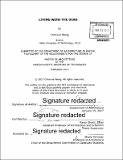| dc.contributor.advisor | Rania Ghosn. | en_US |
| dc.contributor.author | Wang, Chenxue | en_US |
| dc.contributor.other | Massachusetts Institute of Technology. Department of Architecture. | en_US |
| dc.coverage.spatial | n-us-ny | en_US |
| dc.date.accessioned | 2017-05-11T20:00:38Z | |
| dc.date.available | 2017-05-11T20:00:38Z | |
| dc.date.copyright | 2017 | en_US |
| dc.date.issued | 2017 | en_US |
| dc.identifier.uri | http://hdl.handle.net/1721.1/109013 | |
| dc.description | Thesis: M. Arch., Massachusetts Institute of Technology, Department of Architecture, 2017. | en_US |
| dc.description | Cataloged from PDF version of thesis. | en_US |
| dc.description | Includes bibliographical references (page [77]). | en_US |
| dc.description.abstract | This thesis seeks to reimagine the space for the anonymous dead in New York City by proposing a new scenario for burial on Manhattan, which reconnects the alienated community and program to the heart of the city and other civic activities. The construction of the architecture proceeds as the substances transformed from human bodies accumulate. The processes of the transformation are embraced to perform new rituals for the anonymous New Yorkers. Meanwhile the architecture decays and deteriorates as its self-weight grows. Such cyclical processes continue to happen on the site. Urbanistically, the thesis argues that the status quo of anonymous burial is spatially circumscribed and finite, geographically dispelled and demographically unequal, and there's a conflict between the scarce space for the living and the dead, as part of the "ever-accumulating past" of the city. Thus attempts to generate a new urban dynamic should be made. Moreover, using death space as one incidence, the thesis intends to criticize Manhattan's habit of expelling and outsourcing unwanted infrastructual elements at the expense of sacrificing other landscapes instead of absorbing and resolving the issues. Architecturally, it challenges the typology of a cemetery as a picturesque park that has been embraced to cover up the deceased since 18th century despite the continuous urbanization, and explores alternative configuration, materiality, spatial quality and events associated with the burial process. | en_US |
| dc.description.statementofresponsibility | by Chenxue Wang. | en_US |
| dc.format.extent | 77 pages | en_US |
| dc.language.iso | eng | en_US |
| dc.publisher | Massachusetts Institute of Technology | en_US |
| dc.rights | MIT theses are protected by copyright. They may be viewed, downloaded, or printed from this source but further reproduction or distribution in any format is prohibited without written permission. | en_US |
| dc.rights.uri | http://dspace.mit.edu/handle/1721.1/7582 | en_US |
| dc.subject | Architecture. | en_US |
| dc.title | Living with the dead | en_US |
| dc.type | Thesis | en_US |
| dc.description.degree | M. Arch. | en_US |
| dc.contributor.department | Massachusetts Institute of Technology. Department of Architecture | |
| dc.identifier.oclc | 986529539 | en_US |
